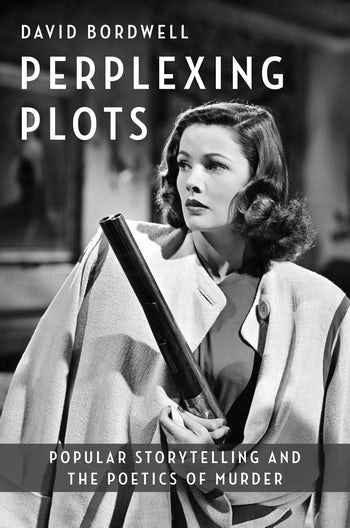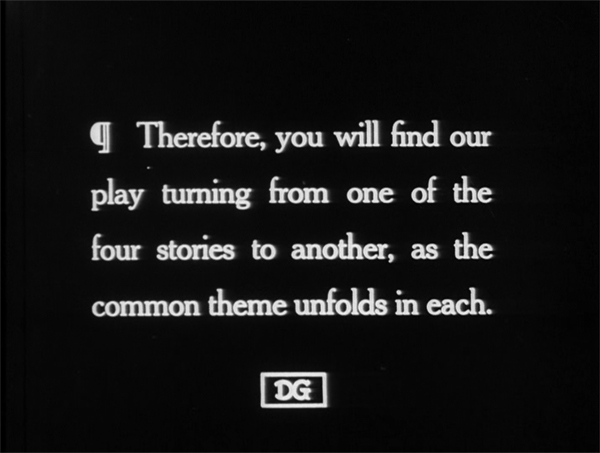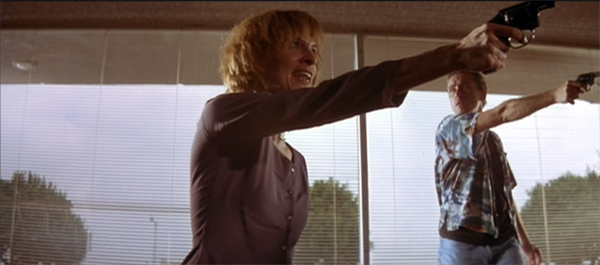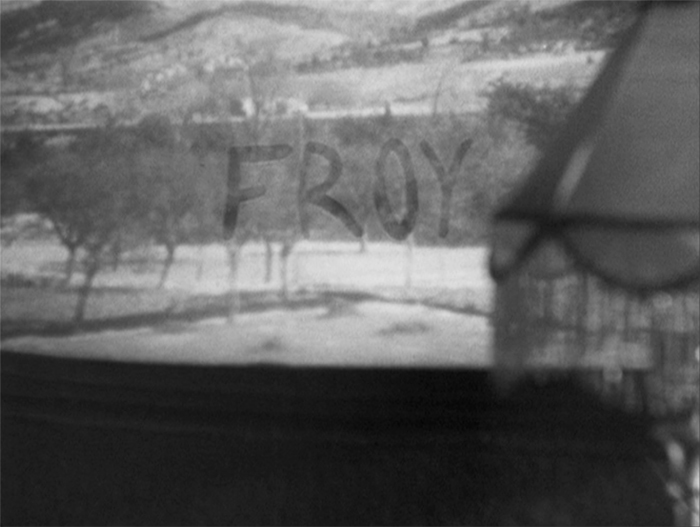PERPLEXING PLOTS: On the horizon
Tuesday | April 26, 2022 open printable version
open printable version
DB here:
In the Before Times, I didn’t watch much fictional TV. Our modest monitor was chiefly a delivery device for news, DVDs, and Turner Classic Movies. We followed The Simpsons, and I came to like Deadwood and Justified, but usually the time commitment demanded by long-form series put me off. I gave my curmudgeonly reasons long ago on a blog entry.
But over the last nine months, forced to stay home, I dipped my toe in the water. Streaming made it easy to catch up with shows I’d never seen and offered a plethora, or rather a glut, of original series. This still-limited experience of long-form shows confirms the presence, if not the dominance, of what Jason Mittell in his excellent book calls Complex TV.
Many shows mix timelines with abandon. Both the documentary WeWork; or, The Making and Breaking of a $47 Billion Unicorn (2021) and the docudrama WeCrashed (2022) open near the end of the story action and then flash back to show what led up to it. (This crisis structure became especially common in 1940s Hollywood.) Billions, an older series I’d never followed, contains an episode (Season 2, 2016) that jumps to and fro among a funeral, scenes taking place before it, and scenes afterward, several attached to different characters. In the Hulu series Dopesick (2021) a sliding timeline graphic shifts among many periods and character viewpoints; to keep track of it all you’d need to make a spreadsheet. (It would amount to something like the whiteboard used in writers’ conference rooms to map out the unfolding series.) I can’t recall all the shows that friends have recommended as examples of daring play with narrative.
Of course all this isn’t news. For years both indie films and Hollywood blockbusters have offered complicated segmentations, broken timelines, and splintered viewpoints, with contradictory replays and unreliable narration. Still, it was good to be reminded that the problem I’m tackling in my latest book is still current—indeed, dominant. We may have to wait for the new Justified series to see a return to straightforward linear storytelling.
When and how did viewers develop the skills that lets them appreciate the New Narrative Complexity? This is at the center of Perplexing Plots: Popular Narrative and the Poetics of Murder.
Maybe we were always smart
Intolerance (1916).
There’s a view, most eloquently posed by Steven Johnson in Everything Bad Is Good for You, that these comprehension skills are a fairly recent development. They stem from rising IQ levels, growing facility with video games, and other cultural phenomena after the 1970s. People are now smarter consumers of narrative than they were in the days of I Love Lucy.
I argue instead that popular narrative has been cultivating these skills across a much longer period, and they firmly took hold in mass culture at the start of the twentieth century. You can get a summary of my argument here on the Columbia University Press site.
Most broadly, a lot of (now-forgotten) mainstream plays and novels were as experimental in shifting point-of-view and juggling time frames as any we find today. For example, we celebrate backwards stories as typical of the demands of modern storytelling. The play and film Betrayal and the films Memento and Shimmer Lake are among many recent media products presenting the scenes in 3-2-1 order. But this possibility was discussed by a prominent critic in 1914, and soon a major woman actor wrote a play that used reverse chronology. There followed other examples, not least W. R. Burnett’s novel Goodbye to the Past (1934) and the Kaufman and Hart play Merrily We Roll Along (1934).
Some will argue that innovations of popular narrative are dumbed-down borrowings from modernist or avant-garde trends. I try to show this process as a two-way dynamic: modernism borrowing from popular forms, mainstream storytellers making modernist techniques more accessible. But we also find that popular storytelling has its own intrinsic sources of innovation, as with the reverse-chronology tale and Griffith’s application of crosscutting to different time frames in Intolerance (1916).
So it seems to me that audiences have long been capable of tracking the sort of fancy narrative devices we find now. They encountered them in many types of stories, and I devote the first part of Perplexing Plots to a quick survey of developments in novels and plays. (Yes, Stephen Sondheim is involved.) Audiences have learned to enjoy self-conscious artistry, an awareness of form and technique–what one disapproving reviewer of Wilkie Collins called “the taste of the construction.”
Such a taste was cultivated in depth in one mega-genre. That was a major training ground for giving us the skills to follow complex, sometimes deceptive storytelling.
Mystery on my mind
Pulp Fiction (1994).
Ever since my teenage years I’ve been a fan of mysteries on the page and on the screen. I’ve smuggled discussions of detective stories and crime thrillers into many of my books, and my last one, on 1940s Hollywood, did a lot with this form of storytelling–largely because it was so central to the films of that era.
Perplexing Plots in a way turns Reinventing Hollywood inside out. The earlier book put movies at the center while showing how filmmakers borrowed from mysteries in other media. The new one puts fiction, theatre, radio, and even comic books at the center, discussing how mystery conventions developed–and showed up in films as well. The two books complement each other, I guess, although the historical sweep of the new one runs from the 1910s to the present.
Mystery was essential to many classic novels, from Wuthering Heights to the tales of Henry James and Joseph Conrad. Dickens and Wilkie Collins made mystery a major attraction of “sensation fiction.” In the twentieth century, the Anglo-American whodunit, the suspense thriller, and the hardboiled detective tale–to take the three most well-known genres–trained audiences in appreciation of nonlinear plotting, misleading narration, and subterfuges of concealment.
A Western or a science-fiction tale may include a mystery, but it doesn’t have to. In mystery fiction, the suppression and misinterpretation of information is foundational to the genre itself. A mystery depends on a “hidden story,” which will often be revealed out of chronological order and refracted through the minds of several characters. At a meta-level, the genre cultivates a gamelike approach, where we expect the author to give with one hand and take away with the other. Across history, a mass audience became sophisticated consumers of complex narratives.
I trace how this happened with Agatha Christie, John Dickson Carr, Marie Belloc Lowndes, E. C. Bentley, Dashiell Hammett, Raymond Chandler, Daphne du Maurier, Cornell Woolrich, and many other authors. I spend a lot of time analyzing both plot structure and the texture of the writing. If nothing else, I hope to show that this genre encourages not only great ingenuity in plotting but also subterfuges of style.
I trace this process into the 1940s, when in my view the basics of contemporary techniques crystallized and become widespread. The book then looks at some case studies of how crime novels and films have explored the various possibilities of broken timelines, disparate viewpoints, and misleading narration. I devote chapters to Erle Stanley Gardner, Rex Stout, Patricia Highsmith, Ed McBain, Donald Westlake, Quentin Tarantino, and Gillian Flynn.
I could have gone much farther. Every reader will have a long list of authors I’ve omitted. But I had to stop somewhere! And I decided to concentrate on some of my favorites. The result is, if nothing else, appreciations of the verbal artistry of some underestimated storytellers.
This isn’t to say that audiences of 1920 could have easily followed Inception (2010) or Everything Everywhere All At Once (2022). Storytellers have pushed forward, revising schemas that are widely known and teaching us to recognize the tweaks they’ve introduced. Audiences have accumulated a repertory of skills, built upon their experiences of other formal experiments. Those experiences, I want to show, have been crucially shaped by the conventions of mystery narratives.
Looking back on other things I’ve written, I find that I’m repeatedly concerned with finding beauty in popular genres and modes of storytelling. My studies of Hollywood, Hong Kong cinema, Japanese films, and other forms of cinema have taught me that mass entertainment harbors not only pleasures but also precise craft and daring artistry. While I’ll never give up my love of disruptive and “difficult” work, I find that films appealing to wide audiences, from His Girl Friday and Meet Me in St. Louis to the masterworks of Ozu and Hitchcock and Lang, have a unique power. Fortunately, we don’t have to choose.We can have them all. Perplexing Plots is my effort to show that storytelling craft in its humblest forms can yield its own rapture.
Advance appraisals of the book can be found here. (Click on “Reviews.”) It’s due to be published in January 2023. In the months ahead, from time to time I hope to blog more about the ideas in the book. In the meantime, I wait for the new installment of Slow Horses.
There are too many people to thank here; my debts are recorded in the book’s Acknowledgments. But at least I want to thank John Belton for supporting the project, and Philip Leventhal and Monique Briones at Columbia University Press for their swift and efficient work on the manuscript. And love to Kristin, who took care of me while I finished the book and recuperated from surgery.
The Lady Vanishes (1938).

















